2014 Yamaha SR Viper Review
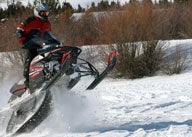
Yamaha's bold new Viper redefines the basics
In all of our very many seasons observing the business of snowmobiling, we’ve never seen anything like this Yamaha and Arctic Cat collaboration. The Suzuki and Arctic Cat partnership of the 1970s proved interesting, but more significant was the bond between Suzuki and the born-again Arctic Cat of the 1980s. With Arctic Cat under the Arctco ownership banner flown by former employees of the bankrupt Arctic Enterprises, Suzuki stood behind the start up with engines and, ultimately, a purchase of “B” Stock, which gave the Japanese partner about a third of the operation. Fast forward to 2013 and Suzuki’s major presence has faded as Arctic bought out the Suzuki financial influence and prepares to move forward with new engine choices, including some tried-and-true Suzuki designs.
Added to the engine choices are one new all-Arctic Cat two-stroke 600cc twin and one proven Yamaha four-stroke triple. For Arctic Cat’s part the use of the engine and collaboration with Yamaha should be an unqualified win. From Arctic Cat’s perspective.
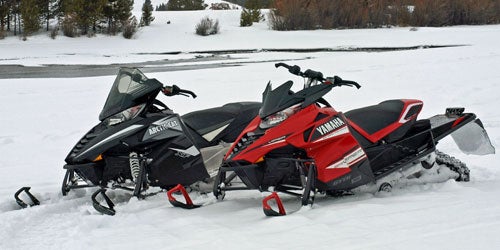 Arctic Cat’s ZR 7000 series (left) and Yamaha’s Viper series (right) are born out of the Yamaha/Arctic Cat collaboration.
Arctic Cat’s ZR 7000 series (left) and Yamaha’s Viper series (right) are born out of the Yamaha/Arctic Cat collaboration.From the Yamaha perspective, the hook-up remains a very calculated gamble, but a gamble it is! Arctic Cat gets a proven engine that gives it a new four-stroke option with two-stroke like performance. The Yamaha triple really comes alive in the Procross chassis. It revs more freely than the Suzuki four-stroke it replaces and it offers more horsepower and lighter weight, too! It’s a winning combination for Arctic Cat. So, how can this be a gamble for Yamaha and not a win-win for both companies?
Yamaha’s image of late would seem to be diametrically opposed to Arctic Cat’s image of performance first and everything else second. Well, that’s a bit unfair, but check out the Arctic Cat rider. They are not wallflowers. They ride decked out in hues of screaming lime green and put a premium on light-ish weight sleds that carry heavy doses of horsepower and serious bite for acceleration and cornering.
The Yamaha rider tends to be a bit older, very experienced but more demanding of quality, reliability and a disdain for things that don’t fit just right or tend to fall off. Of course, Yamaha marketing and engineering hasn’t really offered much to sway a Cat guy to try a Yamaha, even the immensely quick and fast four-cylinder Apex series. In reality the modern Yamaha snowmobile leads in innovation with its electric power steering and “trick” electronically controlled EXUP exhaust. Despite Yamaha’s innovation, incredible attention to fit and finish and reliance on long-term testing that give its brand incredible resale, snowmobile enthusiasts have managed to contain their enthusiasm and stayed away from Yamaha snowmobile dealerships.
Stem The Tide?
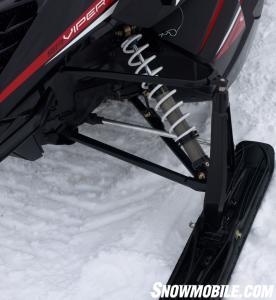 Coil spring over a high-pressure gas shock distinguishes the base Viper front suspension setup.
Coil spring over a high-pressure gas shock distinguishes the base Viper front suspension setup.
The 2014 SR Viper may stem the tide and reawaken a demand for Yamaha snowmobile products unseen since the halcyon days of the first pogo front end Phazers and lightweight rapid response SRX models. We’re over doing it a bit we admit, but if the Viper generates showroom visits, it will be activity that Yamaha dealers haven’t experienced in a while.
As to the actual product, the 2014 SR Viper, it is more than just a Yamaha-logoed Arctic Cat. How much more, we’re uncertain. During our recent test ride sessions in West Yellowstone we came away a bit confused. The base Viper was our first ride of the session. We got about three miles from the test encampment and couldn’t wait to get off it and on the similar Arctic Cat ZR 7000 Sno Pro that was in our group. We knew in the first mile after the switch – awh, heck, we knew within the first 100 yards – that the Arctic Cat was far and away the better option on this day. The Yamaha darted like crazy on the groomed trail while the Cat didn’t waver. How could that be? Mechanically the two sleds were virtually identical.
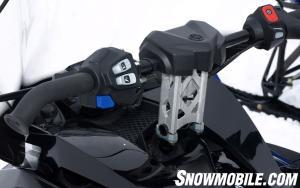 Pre-curved bars and adjustable riser invite rider tenability.
Pre-curved bars and adjustable riser invite rider tenability.
When we left the paddock area, we fought the Viper’s steering. Hey, this is the company that created the Tuner ski. Yamaha knows something about snowmobile skis and handling. But in the case of the first day Viper, the Yamaha crew opted for a single wear bar setup. Arctic Cat’s crew with its three years of experience with the tall spindle front suspension setup went with its standard wear bar choice, consisting of a dual wear rod with flattened bar that stems darting. We also noted that the Viper suspension was set to give instant rearward motion when you hit the throttle. And the Yamaha clutches were tuned for a seeming spike that was missing in the more consistent clutching of the Cat. We had been afraid this might be the direction Yamaha was taking, trying to give the base Viper a berm-lifting “feel” like the snocross-inspired Nytro.
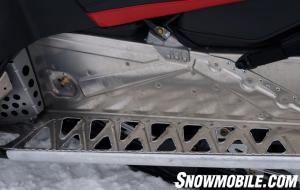 The Viper runningboards are designed to evacuate snow and provide a “grippy” footrest.
The Viper runningboards are designed to evacuate snow and provide a “grippy” footrest.
We complained of these characteristics when we brought the Viper back at the end of the photo ride session. As it happened, that first Viper experience set the tone for four days of evolution. We rode, what we considered a bad choice in setup and progressively rode much better choices in the following days. For our last ride of the session we again rode the base Viper and brought along the upscale RTX SE version as comparison. On this final session, Yamaha pretty much nailed it. The darting was gone, but Yamaha already had addressed that by the afternoon of the first day, replacing the single bar with the dual bar set. The suspension setting was set for trail and not the racer-like big bump spec. And the clutch tuning was a bit less aggressive as well. Based on our many rides of the various settings, we would guess that the production Viper will be suited more for serious trail riding, with the RTX SE offers a bit more of a Nytro feel.
What We Liked
With all that ragging done, let us tell you what we liked about the base Viper. First of all, the seat is excellent. It’s an upgraded version common to both the Cat and Yamaha series. It puts you in a terrific riding position for sitting, cornering or standing. This seat rates as one of the best we’ve experienced in recent years and moves the Viper (and Cat) into elite territory. From previous years, the seat gains a bit of height front to rear as well as a flatter bun-catcher profile and good inward taper to encourage aggressive cornering. This all works with the pre-curved handlebars and adjustable riser to give you a cockpit designed for personal tune-ability.
The Viper windscreen works great. Although not as dynamically stylish as the wind disrupter on the RTX SE, the Viper unit is more traditionally styled with nice edge deflectors to protect your hands. All controls are easy to reach, but we found the push button reverse indented a bit too much for easy operation with a gloved mitt. The new digital gauge is quite something with its dual screen arrangement that allows you to configure each independent of the other. Expect the normal things like speed, rpm, and trip mileage as well as fuel level, exhaust temperature, and such things as altimeter read outs.
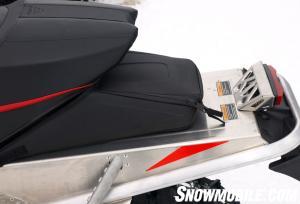 The so-called base Viper comes with this rear storage bag and heated seat.
The so-called base Viper comes with this rear storage bag and heated seat.
Supposedly the Viper will be the basic model in this SR Viper series of RTX, LTX and XTX models. Don’t let “basic” fool you. The base Viper offers a heated seat with the control switch on the console. There’s also a handy rear seat storage bag. The SE models get neither of these pieces.
The base Viper doesn’t get the super premium shock package for the tall spindle front end, designated as the SRV front suspension. Instead, you get a very easily tuned coil over high-pressure gas shock with internal floating piston. The RTX SE features air shocks. Frankly, we’re a bit lazy and like the more basic shock as we can simply spin our shock spanner to add a little more aggression to our front-end bite.
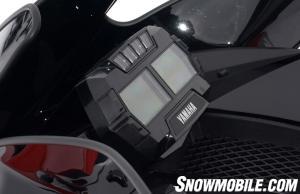 This dual panel digital gauge can be easily configured.
This dual panel digital gauge can be easily configured.
The rear suspension bears more than a passing resemblance to the Arctic Cat slide-action design. Yamaha calls the Viper rear the Dual Shock SR 129, but you’ll find the same inch of sliding action that helps couple the front and rear arm for exceptional control when accelerating or decelerating. We make no pretensions, this rear suspension works very well and is simple enough for a writer to tune. No, it doesn’t have multiple dials to spin or an angled external shock. It’s relatively simple and that’s its strength. It works and doesn’t cause a major freak-out for adjustments. It simply features a set of aluminum bodied high-pressure gas shocks that work in combination with a torsion spring to control 13.5 inches of travel.
Ride & Respond
Now, then, after the sled has established itself with a good setup, how does it ride and respond? Top tilt! Compared to the older Suzuki-powered versions of the Procross platforms, the Viper is a screamer. Regardless of the clutching state of tune, you can fully appreciate the Yamaha triple as being much more rev-happy and able to reach greater mid and top end performance levels. Plus, we understand that the three-cylinder Yamaha is about 10-pounds lighter than the Suzuki four-stroke twin. There’s no need for electric power steering with the Viper.
Where you knew that the Suzuki was a lumbering four-stroke, the Yamaha 1049cc and its nearly 10 more horsepower makes you forget the four-stroke/two-stroke thing as the Viper performs like any other sled in its category. Of course, the ability to use the Yamaha triple’s exceptionally smooth and linear grade torque to power off a turn is a big plus for us motorcycle-brained riders. There’s just something about rolling on that steady infusion of power that gets us excited. Must be like casting the perfect fly or hitting the perfect golf shot.
We did notice that Yamaha intends to make the Viper – all the Vipers – have its own performance signature. You need to know that although the Yamaha triple’s intake and exhaust will be all Arctic Cat intake mapping and three-into-one exhaust with a sound deadening silencer shaped like a carry-on flight bag, the clutches are Yamaha and not Arctic Cat as with the ZR 7000 series. This is where Yamaha will differentiate its attitude. We got a clue as to the intended difference on our last Viper ride of the session. The belt bite on the Viper is set to provide a moderate amount of engine braking, where the Arctic Cat versions are more free rolling. Neither is good or bad, merely a performance “tell.” And, we suspect that the overall engine and clutch tuning with the Viper will hint at the Nytro’s more aggressive character.
Overall, while extremely disappointed with our first impression of the Viper on Day One, by Day Four we were in a much happier place as Yamaha dialed in the specifications. The truth to all this is that the Viper should be a pretty darn good new series of Yamahas that will offer a huge opportunity to Yamaha dealers unlike anything they’ve seen in the past decade. And that’s a win!
| 2014 Yamaha Viper Specs | |
| Engine | Yamaha Genesis four-stroke high-performance 1049cc; bore/stroke of 82.0mm/66.2mm; three-cylinder, liquid-cooled; 41mm electronic fuel injection system; dry sump lubrication |
| Horsepower | 130+ |
| Drive | Yamaha YVXC drive clutch with Yamaha driven |
| Front Suspension | Yamaha SRV tall A-arm with HPG aluminum shocks; up to 10.0-in of travel |
| Rear Suspension | Yamaha Dual Shock SR 129 parallel slide rail; aluminum high-pressure gas shocks; up to 13.5-inches of travel |
| Brake | Radial master cylinder hydraulic brake system with disc mounted on drive shaft |
| Length | 118.0 in |
| Width | 48.0 in |
| Ski Stance | Adjustable 42-43-in |
| Track | 15 x 129 x 1.25 Camoplast Rip Saw II |
| Weight | N/A |
| Fuel Capacity | 10.6 US Gal (Regular fuel) |
| Features | Heated seat, rear storage bag, digital gauge, push button reverse, electric start |
| MSRP | US$12,149 |
Related Reading
2014 Yamaha Snowmobile Lineup Unveiled
The Yamaha and Arctic Cat Collaboration
Yamaha To Supply 4-Stroke Snowmobile Engines to Arctic Cat
2013 Yamaha Nytro Boosted



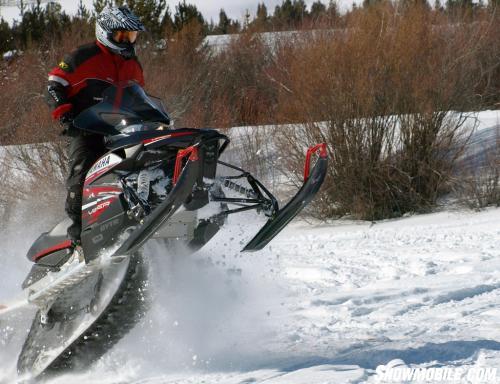
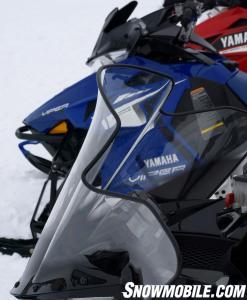
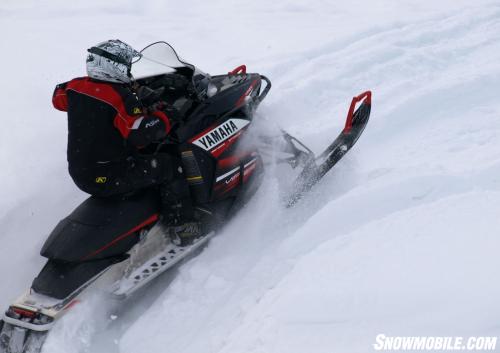





 Your Privacy Choices
Your Privacy Choices